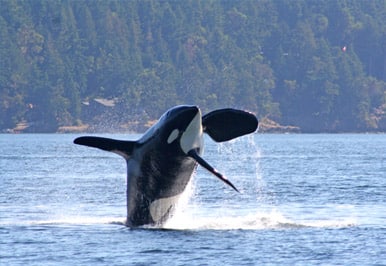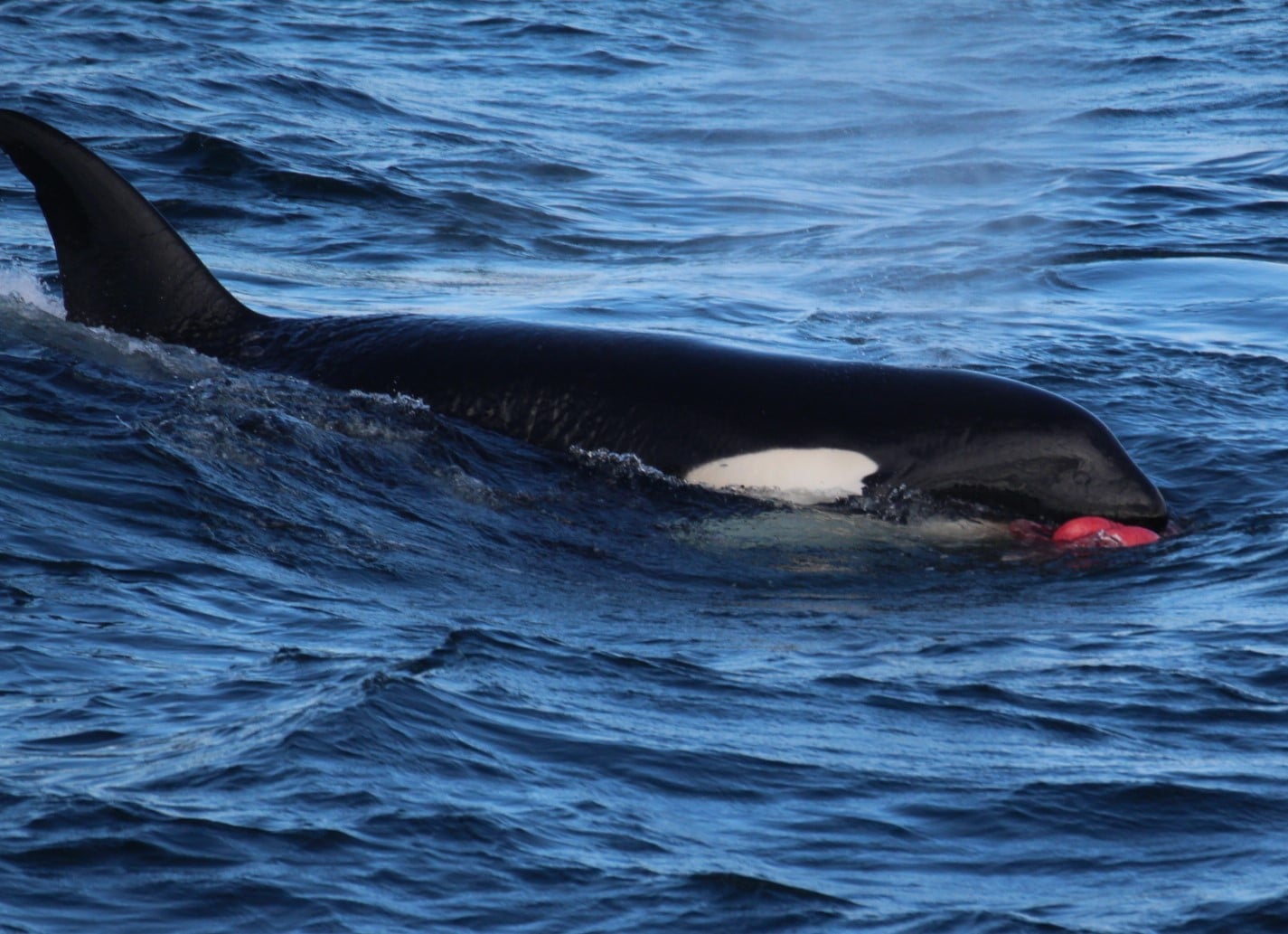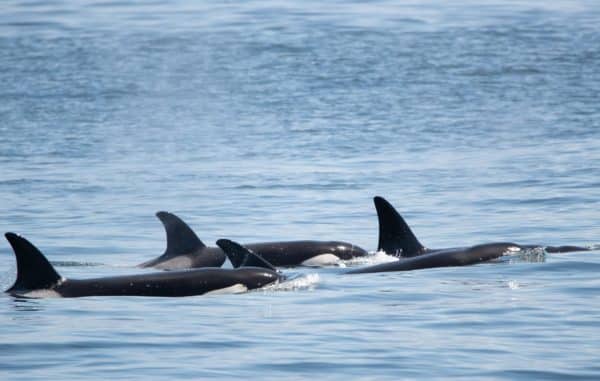Updated: August 14th, 2024
Orcas, also known as killer whales, have a notorious reputation as apex predators in the ocean. Understanding their behavior gives us a deeper appreciation for these intelligent and formidable marine predators. Their interactions with great white sharks, another top predator in the marine ecosystem, reveal fascinating insights into the complexity of oceanic food webs and predator-prey dynamics.
Understanding Orcas & Great White Sharks
Orcas (Killer Whales)
Orcas are highly intelligent marine mammals known for their complex social structures and sophisticated hunting techniques. They are at the top of the food chain, with no natural predators. Orcas are found in all oceans, from the Arctic and Antarctic regions to tropical seas. They are incredibly versatile hunters, preying on a wide variety of marine life, including fish, seals, and even whales. Their intelligence is evident in their ability to communicate using distinct vocalizations and to coordinate complex hunting strategies within their pods.
Great White Sharks
Great white sharks are also apex predators, renowned for their size and hunting prowess. They can grow up to 20 feet long and weigh over 2,000 pounds. Great whites are known for their powerful jaws and sharp teeth, which they use to capture prey such as seals, fish, and smaller sharks. These sharks play a critical role in maintaining the balance of marine ecosystems by controlling the population of other species. Great white sharks are solitary hunters and are typically found in coastal waters where their primary prey resides.
Why do Orcas Attack Great White Sharks?
Predation & Diet
One of the primary reasons orcas target great white sharks is their preference for the nutrient-rich livers of these sharks. The liver of a great white shark can make up a significant portion of its body weight and provides a dense source of calories. Orcas have developed specialized hunting techniques to extract these livers efficiently. This preference for shark livers is part of what drives the aggressive interactions between orcas and great white sharks.
Competition for Resources
Both orcas and great white sharks compete for similar food sources and territories. This competition can lead to aggressive encounters as each species strives to dominate their shared habitat. For instance, both predators often hunt seals and large fish. In regions where their territories overlap, this competition can intensify, leading to direct confrontations between the two species. The presence of orcas in an area can significantly alter the behaviour and distribution of great white sharks, as the sharks tend to avoid regions where orcas are known to hunt.
Learned Behaviour
Orcas are known for their ability to learn and pass down hunting techniques within their pods. This social learning and teaching are crucial for their survival and success as hunters. Young orcas observe and imitate the hunting strategies of older, more experienced members of their pod. This includes the specific methods used to hunt great white sharks. Such learned behaviour ensures that these hunting techniques are preserved and refined over generations, making orcas even more effective predators.
How do Orcas Hunt Great White Sharks?
Orcas employ specific hunting techniques when targeting great white sharks. One of the most notable methods involves flipping the shark onto its back, inducing a paralytic state known as tonic immobility. Once immobilized, the orcas focus on extracting the shark’s liver. This coordinated effort showcases their intelligence and ability to communicate effectively during hunts.
Examples of Coordinated Attacks
In 2015, two orcas named Port and Starboard caused a significant shift in shark behaviour off the coast of South Africa. Great white shark carcasses with their livers removed began washing up on beaches, leading to the departure of other great whites from the area. This event devastated the local shark diving tourism industry. The orcas’ ability to systematically target and extract the livers from great white sharks demonstrates their precision and skill as hunters.
Intelligence and Communication
The ability of orcas to hunt great white sharks highlights their advanced intelligence and communication skills. In 2022, orcas were filmed hunting sharks with four other orcas, demonstrating the spread of this learned behaviour within the population. Orcas use vocalizations to coordinate their movements and strategies during hunts, ensuring that each member of the pod knows their role. This level of cooperation is a testament to their sophisticated social structures and cognitive abilities.
What is the Ecological Impact of Orca Attacks on Great White Sharks?
Changes in Great White Shark Behaviour and Distribution
Orca attacks have led to noticeable changes in great white shark behaviour and distribution. Sharks tend to avoid areas where orcas are known to hunt, leading to shifts in their usual habitats. This can have significant implications for the broader marine ecosystem, as the presence or absence of great white sharks can influence the populations of their prey species.
Effects on the Marine Ecosystem
The predation of great white sharks by orcas can have a significant impact on the marine ecosystem. By targeting sharks, orcas help balance the predator-prey dynamics, potentially leading to increased populations of other marine species. For instance, the removal of great white sharks from an area can result in a rise in the populations of seals and other prey species, which in turn can affect the distribution and abundance of fish and other marine organisms.
Balancing the Predator-Prey Dynamics
Understanding the interactions between orcas and great white sharks is essential for appreciating the complexities of marine predator competition. These interactions play a crucial role in maintaining the health and balance of marine ecosystems. The predatory behaviour of orcas towards great white sharks is a natural part of the ocean’s ecological balance, demonstrating the dynamic and interconnected nature of marine life.
Conclusion
Orcas and great white sharks are both apex predators with unique roles in the marine ecosystem. The predatory behaviour of orcas towards great white sharks showcases their intelligence, communication skills, and the intricate balance of marine life. These interactions highlight the complexity of the ocean’s food web and the ongoing competition for survival among its top predators. Understanding these dynamics not only enhances our knowledge of marine biology, it also underscores the importance of conserving these magnificent creatures and their habitats.
If you would like to learn more about orca and other marine wildlife behaviour, visit our Wildlife Learning Centre. To learn more about orcas first-hand from a trained naturalist, book a whale watching tour today.
FAQs
Do Orcas always kill the sharks they attack?
Orca predation on Great White Sharks is a relatively new and not a commonly observed behavior. Therefore, scientists do not yet have a statistic on how successful the attacks are or are not. However, the orcas’ ability to systematically target and extract the livers from great white sharks demonstrates their precision and skill as hunters.
Are Orcas the only predators of the Great White Shark?
Although Great White Sharks were once known as the apex predator of the ocean, recent events suggest otherwise. At this time, Orcas are the only recorded predators known to prey on Great White Sharks, ultimately making them the Apex predator.
How do Great White Sharks respond to Orca presence?
The presence of orcas in an area can significantly alter the behaviour and distribution of great white sharks, as the sharks tend to avoid regions where orcas are known to hunt. In 2015, 2 orcas targeted Great White Sharks off the coast of South America. Following these attacks, the Great White Shark population completely disappeared. Speculation of Orca Attacks on Great Whites off the cost of New Zealand has triggered researchers to start looking more closely at their shark population and how these suspected attacks may impact the distribution of the Great White Shark population.












